The Role of AI in E-commerce: Boost Sales, Automate Smarter
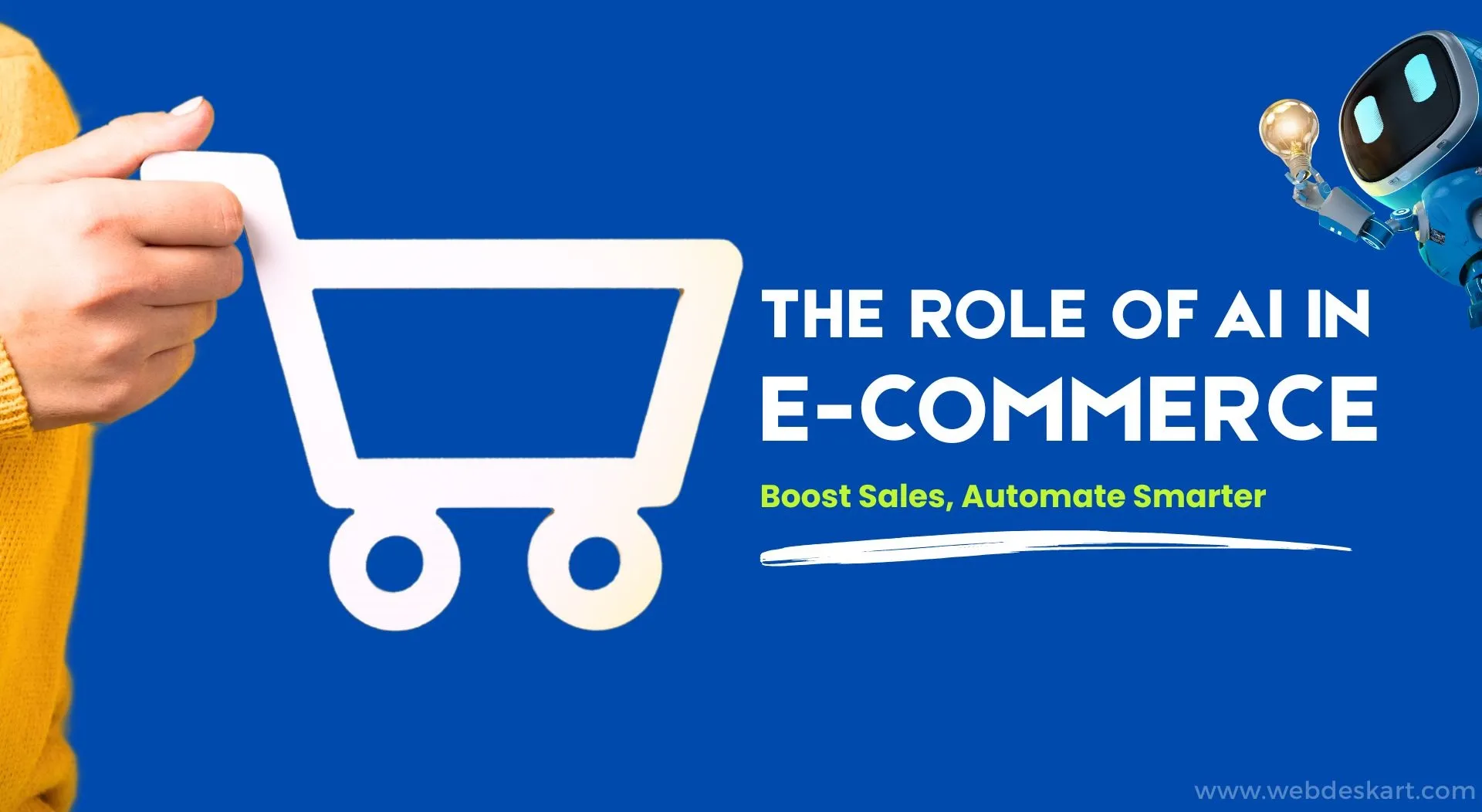
 Puja Srivastava / July 9, 2025 / Web Technology / Total: 827 Views
Puja Srivastava / July 9, 2025 / Web Technology / Total: 827 ViewsOne must realize that in today’s highly competitive e-commerce world, the customer expects personalization, immediate support, and smart product suggestions. This article discusses the role of AI in transforming online businesses in terms of having personalized shopping and automated customer service, smart inventory management, and dynamic pricing and others. Find out how leading brands boost sales with AI, like Amazon and Nike, and practical tips to make your store intelligent and more profitable. Whether you’re starting afresh or scaling operations, this might be the secret sauce for successful e-commerce.
You plan to take your business online. Maybe you already have. You buy a domain, invest in fast and reliable hosting, and hire a professional developer to build your e-commerce website. You list great products, offer heavy discounts, and wait for the orders to roll in.
But something’s off. The traffic is low, conversions are slower than expected, and customers aren’t staying long.
The truth is: just having an online store isn’t enough anymore.
The digital marketplace has evolved. Visitors expect personalization, instant support, and smarter recommendations, and they expect it fast. That’s where AI comes in.
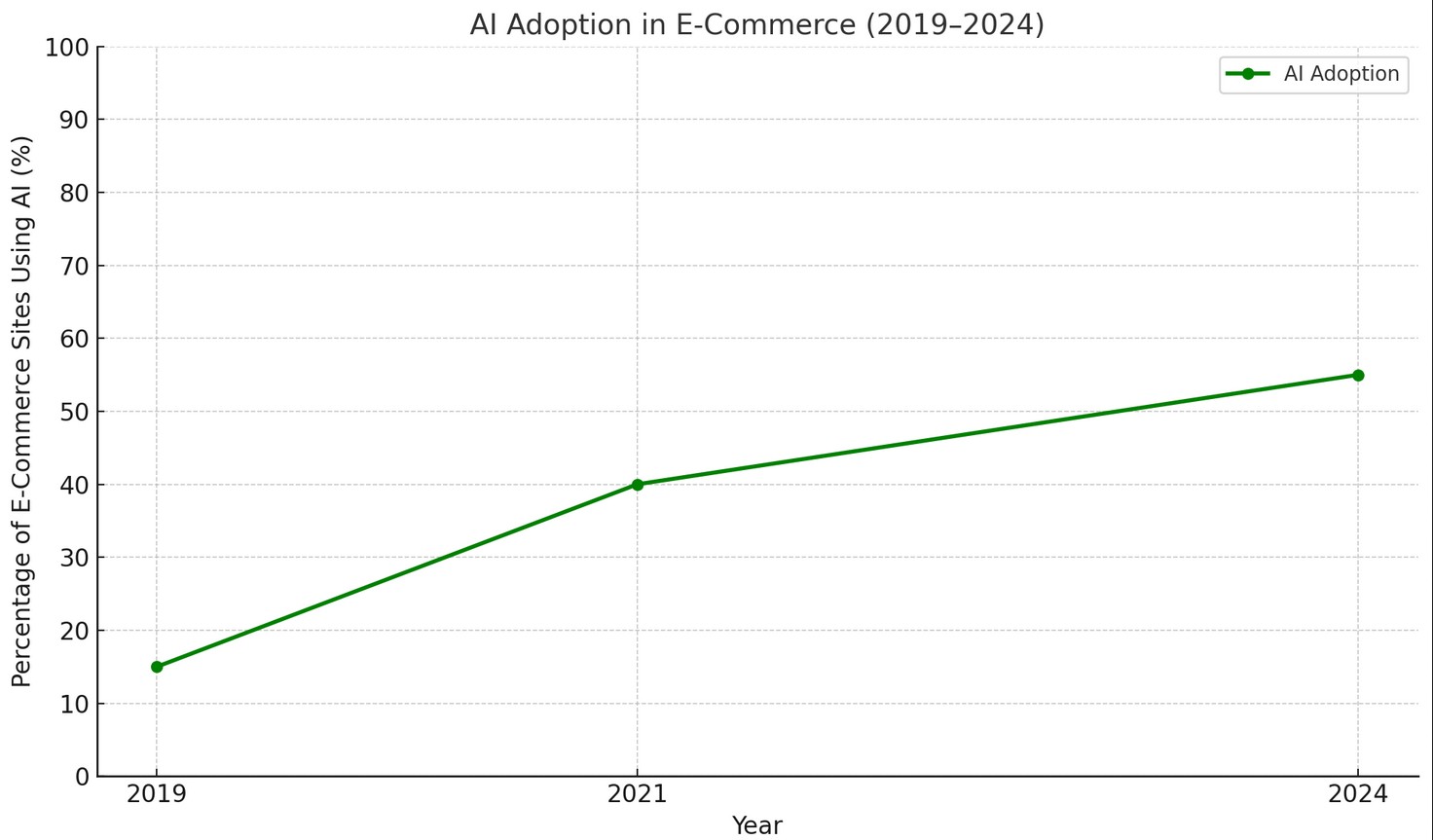
This chart is based on real industry data showing AI adoption in e-commerce from 2019 to 2024. The trend confirms significant growth, especially post-2021, with over 50% of online stores now using AI-powered features.
In this article, we’ll explore The Role of AI in E-Commerce. So let the fun begin!
What AI Brings to Your E-commerce Site?
AI can sift through tons of information in a flash, spotting trends and predicting things that would take humans forever.
Personalized Shopping Experiences: Making Every Visitor Feel Special
- Imagine walking into a physical store where the salesperson knows your preferences, and recommends exactly what you’d love. That’s what AI does for your online store.
- How AI Helps: AI algorithms track a customer’s Browse history, past purchases, viewed items, and even how long they spend on certain pages. It uses this data to offer highly relevant product recommendations.
Examples on Websites:
“Recommended for You” sections: So, you know those “Recommended for You” sections, like on Amazon? That’s AI doing its thing. It figures out what you might like based on what other people who bought similar stuff also bought – it’s not just random picks.
- Dynamic Homepages: AI can actually change the layout and featured products on your homepage for each unique visitor, showing them what they’re most likely to engage with based on their past behavior.
- Personalized Email Marketing: AI can segment your customer list into tiny groups based on their interests, sending highly targeted emails about products or deals they’re truly interested in, instead of generic newsletters.
Did you know? Dynamic emails can be AI-generated and personalized for each customer using tools like Mailchimp with AI send different emails based on what your user has viewed or purchased.
Smart Customer Service: Always Open, Always Helpful
- Providing 24/7 customer support can be a huge challenge. AI-powered tools bridge this gap, offering instant assistance without the need for a large human team.
- How AI Helps: Chatbots and those virtual assistants are getting super smart. They use clever computer language stuff (NLP, or something like that) to understand what people are asking, even if they don’t say it perfectly. They can handle common questions, point people to the right stuff, track orders, and even sort out simple returns.
Examples on Websites:

- Chatbots on Product Pages: Lots of smaller online stores now have those little pop-up chat windows. They’re handy – you can quickly ask about things like what features a product has, if it’s in stock, or how long shipping will take.
- Automated Order Tracking: Forget calling or emailing to track your order! Just type your order number into a chatbot and it’ll give you the latest info right away.
- Pre-purchase Assistance: A customer might ask, “Will this shirt fit me if I’m usually a large?” An AI bot, if trained on your product data, could provide sizing advice or recommend similar items in their size.
Did you know? You can set up AI pop-ups that reacts in real-time. For example, a pop-up that triggers with a discount when a user is about to exit the page (like with OptinMonster).
Optimized Inventory Management: Never Run Out (or Overstock)
- Inventory management? It’s a real pain, right? Too much stock and you’re stuck with extra costs, too little and you miss out on sales. But AI is changing the game.
- How AI Helps: AI looks at past sales, what sells well at different times of year, our marketing efforts, and even things like holidays or the weather to guess how much we’ll need – and it’s surprisingly good at it.
Examples on Websites:
- While not directly visible to customers, if you use a shopping app with AI inventory smarts, it means your favorite things are actually there when you want them. No more annoying “out of stock” messages, which is always a win.
- And for small businesses, it’s a lifesaver. You don’t get stuck holding onto stuff that just isn’t selling, freeing up some cash.
Dynamic Pricing: Staying Competitive and Profitable
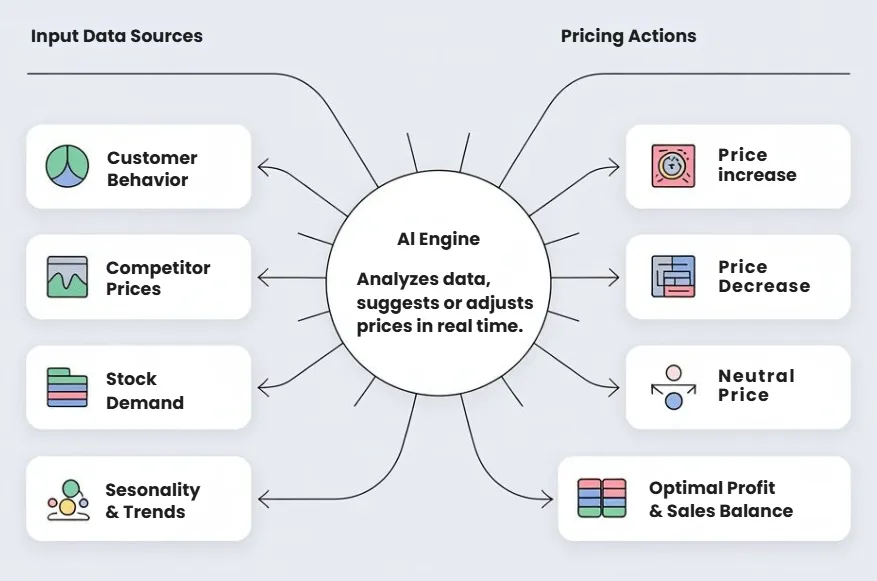
- Getting the price right is super important. AI can really help you keep your stuff competitive and make more money.
- How AI Helps: Clever AI programs look at things like what people are buying right now, what your competitors are charging, how customers act, and even how much you have in stock. Then, it either suggests a price or even changes it automatically to sell more and make you more profit.
Examples on Websites:
You might not see it, but when a popular item starts selling fast, AI could slightly increase its price. Conversely, if a product isn’t moving, AI might suggest a small discount to clear stock. This ensures you’re always getting the best possible price without manual effort.
Enhanced Search and Discovery
- Customers expect to find what they’re looking for quickly. AI supercharges your website’s search capabilities.
- How AI Helps: AI-powered search understands natural language better than traditional keyword searches. It can also enable visual search, allowing customers to upload an image to find similar products.
Examples on Websites:
- Smarter On-site Search: Instead of just looking for exact matches, a good AI search engine gets what you mean. So, if someone searches for “summer wedding dress,” it’ll find the right things even if the description doesn’t use those words exactly.
- Visual Search: Imagine a customer sees a handbag they like in a magazine. With an AI-driven visual search feature (like some fashion e-commerce sites offer), they can upload a photo of the bag, and your site will show similar items from your inventory. This turns inspiration into immediate sales opportunities.
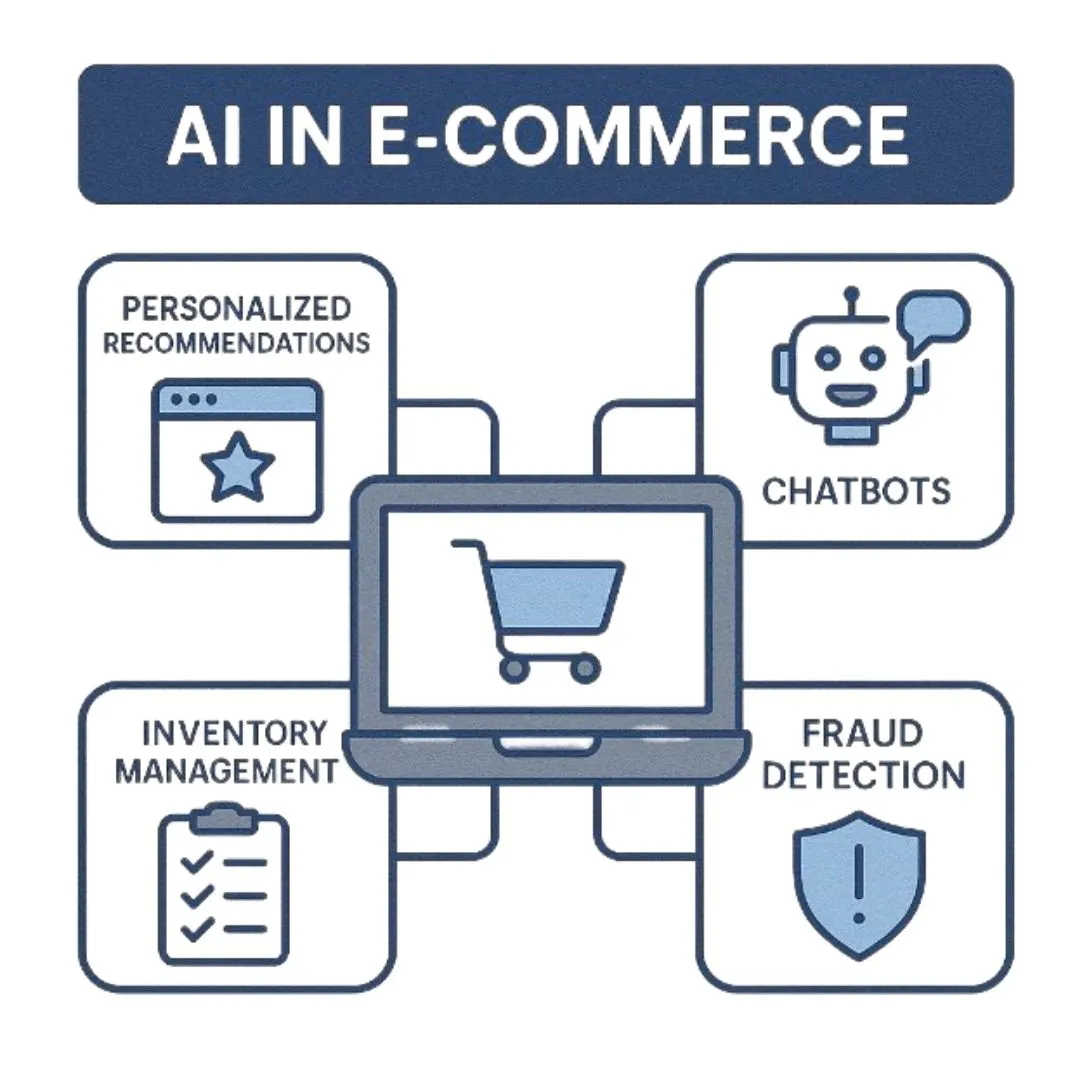
Real-World Examples of AI in Action
Let’s look at how some real websites are using AI to transform their business:
- Amazon: The king of product recommendations. AI looks at what you’ve searched, clicked, or bought — and suggests items you didn’t even know you wanted.
- Nike: Their website uses AI to personalize your shopping experience. From shoe size prediction to style preferences, the site learns about you and adapts accordingly.
- Zyro (Hostinger): A small business website builder that integrates AI for writing content, generating product descriptions, and even designing logos — great for businesses with tight budgets.
- ThriftBooks: This online bookstore uses AI to show users similar books based on what others have browsed or purchased. A great way to upsell and increase cart value.
Quick Tricks for Growing Your AI-Driven Website
Okay, so here are three cool things you might not know about boosting your online sales:
- Think about those people who fill their carts then leave. Tools like Retainful or CartStack automatically send a friendly email, maybe offering a small discount, and you can get back up to 20% of those lost sales! It’s a lifesaver.
- Let customers search with pictures! Imagine, instead of typing words, they can just upload a photo – great for clothes or home stuff. Services like Syte or Pinterest Lens make that happen.
- Use heatmaps! Tools like Hotjar show you exactly where people click, scroll, and get confused on your site. This helps you fix any trouble spots and make everything super easy to use, meaning faster checkouts.
Here’s how a heatmap would look like:
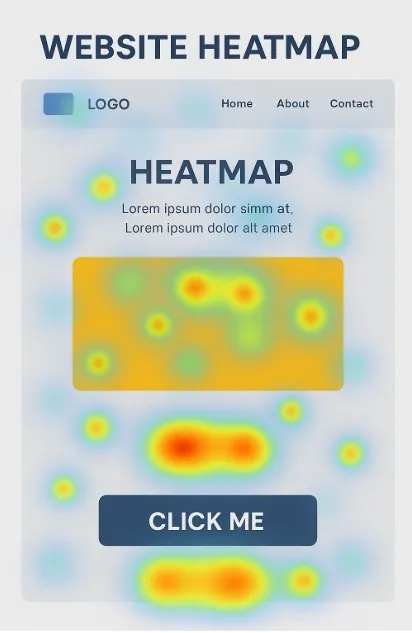
Wrapping It Up!
AI is changing the game for online shops. It’s not just a website anymore; it’s a smart system that really gets your customers. For smaller businesses, that means playing smarter, not harder. Whether you’re just starting or looking to grow, using AI could be the key to serious success.
Want some help figuring out how to add this stuff to your site? We at WebDeskArt are happy to chat or even make a plan specific to your business. Let’s make your shop awesome!
